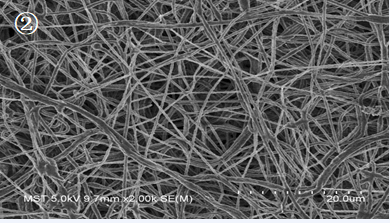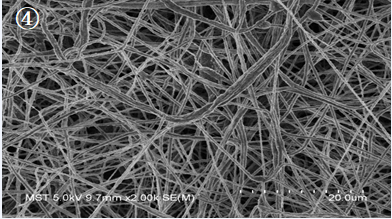疏水疏油型PTFE纳米纤维膜的制备及其性能研究毕业论文
2020-04-22 19:38:50
摘 要
聚四氟乙烯(PTFE)具有优异的热化学稳定性、疏水性等性能,广泛的应用于空气净化领域。然而,在含油烟气净化中,由于PTFE材料的亲油性,当过滤含油气体时,油滴会粘附在过滤膜表面造成孔道堵塞,降低了过滤效率以及膜的使用寿命。为此,我们对其进行表面双疏化处理,使其具有疏水疏油性。静电纺丝法作为一种制备纳米纤维的方法,具有高孔隙率,大的比表面积以及高的气体渗透性,且制备工艺相对简单,同时制备的纳米纤维便于表面功能化处理。因此,利用同轴静电纺丝技术,将ZnO包裹在PTFE纤维表面,然后在纤维膜表面接枝含氟单体以降低表面能。测量改性前后的疏水疏油性能,与疏水性纯聚四氟乙烯纤维膜相比,改性后的F-ZnO@PTFE纤维膜表现出双疏性,其油水接触角分别达到124°和164°。
关键词:氧化锌 聚四氟乙烯 静电纺丝 疏水 疏油
Preparation of hydrophobic and oleophobic ZnO@PTFE nanofiber membrane by electrospinning
Abstract
Polytetrafluoroethylene (PTFE) has excellent thermochemical stability, hydrophobicity and other properties, and is widely used in the field of air purification. However, in the oily flue gas purification, due to the lipophilicity of the PTFE material, when the oil-containing gas is filtered, the oil droplets adhere to the surface of the filter membrane to cause clogging of the pores, which reduces the filtration efficiency and the service life of the membrane. Therefore, we have double-drained the surface to make it hydrophobic and oleophobic. As a method for preparing nanofibers, the electrospinning method has high porosity, large specific surface area and high gas permeability, and the preparation process is relatively simple, and the prepared nanofibers are convenient for surface functional treatment. Therefore, by using the coaxial electrospinning technique, ZnO is wrapped on the surface of the PTFE fiber, then the fluorine-containing monomer is grafted on the surface of the fiber membrane to reduce the surface energy. The hydrophobic oleophobic properties before and after modification were measured. Compared with the hydrophobic pure PTFE fiber membrane, the modified F-ZnO@PTFE fiber membrane exhibited double heterogeneity, and its oil-water contact angle reached 124° and 164°, respectively.
Key Words: ZnO; PTFE ; Electrospinning; Hydrophobic; Oleophobic.
目录
摘要 I
Abstract II
第一章 绪论 1
1.1 前言 1
1.2 静电纺丝技术 1
1.2.1 静电纺丝的背景 1
1.2.2 静电纺丝的机理 1
1.3 静电纺PTFE在超疏水性纤维膜的发展 5
1.4 对超疏水膜进行疏油改性 5
第二章 实验部分 7
2.1 实验试剂和实验仪器 7
2.1.1 实验试剂 7
2.1.2 实验仪器 8
2.2 实验方案 8
2.2.1 选取试剂 8
2.2.2 ZnO胶体的制备 9
2.2.3 10%PVA的制备 9
2.2.4 纺丝液的制备 9
2.2.5 ZnO@PTFE纳米纤维膜的制备 10
2.2.6 对纤维膜进行含氟单体接枝 10
2.2.7 结构与形貌的测试 10
第三章 结果与讨论 12
3.1 ZnO胶体的表征 12
3.2 纺丝芯液和纺丝壳液的推注量对纤维膜形貌的影响 13
3.3 工作距离对ZnO@PTFE纤维形貌的影响 15
3.4 煅烧前和煅烧后纤维膜的SEM分析 15
3.5 煅烧后纤维膜的热重、XRD分析和ICP分析 17
3.6 纤维膜改性前后的接触角测量 18
第四章 结论与展望 20
4.1 结论 20
4.2 展望 20
致谢 21
参考文献 22
第一章 绪论
1.1 前言
众所周知,油烟气对人体的健康有严重影响,因为它们含有300多种有害物,如苯、甲苯、二甲苯、萘和其他类似的致癌化合物。同时产生的大量含油烟气对当地环境造成严重污染。面对这些问题,现在处理的方法主要有膜分离法、活性炭吸附法、静电沉积法以及热氧化焚烧法,其中膜分离法具有占地面积小,截留率高,能耗低等优点得到广泛应用,但存在膜容易被污染等一些缺点。聚四氟乙烯(PTFE)具有优异的热化学稳定性、疏水性等性能,被广泛应用在空气净化领域。然而,在含有烟气净化中,由于PTFE膜表面的疏水亲油性能,使得油滴易粘附膜表面,堵塞过滤孔道,降低膜的使用寿命及增加过滤压降。双疏膜是目前研究的热点课题,因此,对PTFE膜表面进行疏油化改性,避免在过滤中的一些弊端。
1.2 静电纺丝技术
1.2.1 静电纺丝的背景
静电纺丝是一种制造具有化学、光学、物理性质的纳米纤维的工艺[1-2]。其工艺过程是聚合物溶液在电场中形成射流并经过溶剂的蒸发,从而得到纤维状物质。与其他纤维制造技术相比,例如化学生长,热蘸笔光刻和热挤压。静电纺丝技术可以追溯到1890年代早期,当时Rayleigh首次发现它。现在通用的静电纺丝工艺和装置类似于Baumgarten [4]及其团队于1971年创建的。迄今为止,已有超过100种聚合物溶液成功电纺以获得超细纳米纤维,表明了该技术的多功能性和潜力。由于跨学科应用,导致静电纺丝领域的研究正在迅速增长[5]。
1.2.2 静电纺丝的机理
1、装置
传统的静电纺丝装置包括三个主要部件:
相关图片展示:







您可能感兴趣的文章
- 用于甲醇制烯烃反应的SAPO-34/ZSM-5复合催化剂的原位水热结晶合成外文翻译资料
- 硫化氢在活体的化学发光探针成像外文翻译资料
- 全色发射型ESIPT荧光团对某些酸及其共轭碱负离子识别的颜色变化外文翻译资料
- 一种用于成像神经元细胞和海马组织中NMDA受体附近内源性ONOO-的双光子荧光探针外文翻译资料
- 表面功能化的Ui0-66/pebax基超薄复合中控纤维气体分离膜外文翻译资料
- 金属有机框架中的可逆调节对本二酚/醌反应:固态固定化分子开关外文翻译资料
- 二维MXene薄片的尺寸相关物理和电化学性质外文翻译资料
- 将制甲烷的Co催化剂转化为产甲醇的In@Co催化剂外文翻译资料
- MXene分子筛膜用于高效气体分离外文翻译资料
- 模板导向合成具有排列通道和增强药物有效荷载的立方环糊精聚合物外文翻译资料




